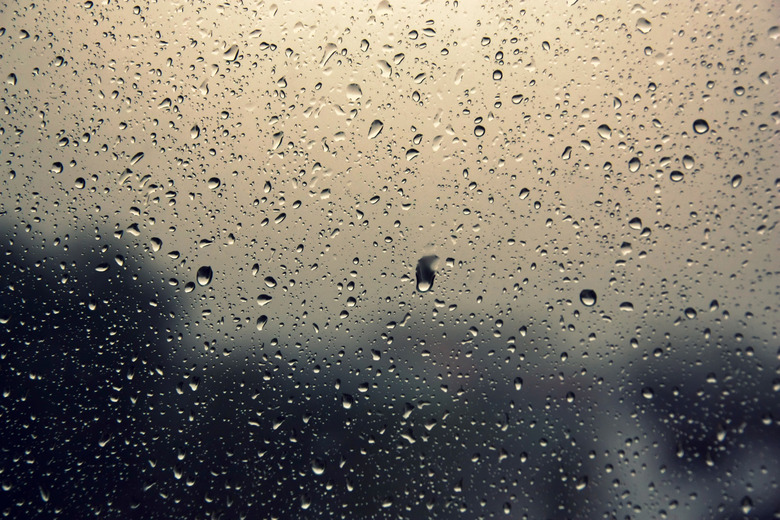What Happens After Water Vapor Condenses?
Water changes between solid, liquid and gaseous states but does not leave the confines of Earth's surface or atmosphere. Water changes through an endless cycle precipitation, evaporation and condensation. When water vapor condenses, it changes from a gas to a liquid.
TL;DR (Too Long; Didn't Read)
Water in its gaseous state is called water vapor. When water vapor condenses, the molecules cool and change into a liquid state.
Phase Changes and Energy Transfer
Phase Changes and Energy Transfer
When water changes from one state of matter to another, the molecules spread apart or move more closely together. The water molecules in ice are packed closely together but are farther apart in liquid water. The molecules in water vapor are even more spread out. Solid ice has the greatest density and water vapor has the lowest density.
The change in density is accompanied by a release of energy when the molecules move closer together, such as when a gas becomes a liquid, or a liquid becomes a solid. When water changes from a solid to a liquid, or a liquid to a gas it absorbs energy from the environment and the molecules spread apart.
The Water Cycle
The Water Cycle
The water cycle allows Earth to maintain its water supply. Heat causes liquid water on Earth's surface to evaporate and change into gaseous water vapor. Most water vapor in the atmosphere evaporates from bodies of water, especially the oceans. Evaporation occurs more quickly as temperature increases.
Humidity is the amount of water vapor in the air. When water vapor in the air cools, the opposite of evaporation occurs: condensation. The condensation definition is water changing from a gas to a liquid. Condensation makes it possible for clouds to form.
Clouds contain liquid water droplets and solid ice crystals. The cooler temperature at high altitudes causes more water vapor to condense. Water vapor condenses on minute particles of debris in the air which then collide with other condensed droplets nearby. Eventually the force of the collisions of these droplets of water causes precipitation to fall from the clouds to the ground and collecting in bodies of water.
Water Vapor Condenses
Water Vapor Condenses
The process in which water vapor turns into a liquid is called condensation. The gaseous water molecules release energy into the cooler air around them and move closer together. The spaces between the molecules decrease until they are close enough to change from a gas to a liquid.
When the air is warmer than the ground, water vapor condenses on ground surfaces to form dew. The temperature when dew forms is called the dew point. A similar effect occurs on the outer surface of a cold beverage, when air temperature is higher than the water in the glass.
Water condensation doesn't always result in cloud formation at high altitudes. Water condenses whenever water vapor cools to a temperature lower than the point when evaporation occurs. Condensation happens near the ground when warm, humid air meets cooler land or water to create **fog,** which is like clouds that accumulate at ground level. Fog forms when the air temperature is equal to the dew point.
After Water Condenses
After Water Condenses
Some of the water vapor in the atmosphere that condenses is stored in clouds. Clouds are more likely to form when the air is humid and contains more water vapor. The energy released when gaseous water vapor condenses to form liquid water droplets is called latent heat. Latent heat from condensation causes an increase in air temperature surrounding the water droplets.
The warmer air rises, causing the water vapor to condense when it meets cooler air at a higher altitude. As more water vapor condenses, cloud volume increases, and the chance of precipitation increases. Instability occurs when clouds increase in height and are surrounded by warmer air. These conditions can trigger thunderstorms.
Liquid or frozen water falls to the surface as precipitation. It can be stored as solid particles in snow or ice or as a liquid in bodies of water. It remains in storage until it reaches the temperature when evaporation occurs, continuing the cycle.
Cite This Article
MLA
Mentzer, A.P.. "What Happens After Water Vapor Condenses?" sciencing.com, https://www.sciencing.com/happens-after-water-vapor-condenses-8458236/. 22 November 2019.
APA
Mentzer, A.P.. (2019, November 22). What Happens After Water Vapor Condenses?. sciencing.com. Retrieved from https://www.sciencing.com/happens-after-water-vapor-condenses-8458236/
Chicago
Mentzer, A.P.. What Happens After Water Vapor Condenses? last modified March 24, 2022. https://www.sciencing.com/happens-after-water-vapor-condenses-8458236/
